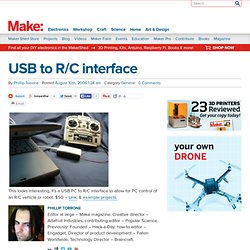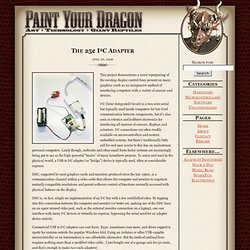

Engines. Arduino. Parts. Pcb. SmartFlix. Electronics. USB to R/C interface. This looks interesting, it’s a USB PC to R/C interface to allow for PC control of an R/C vehicle or robot. $50 – Link.

& example projects. Phillip Torrone Editor at large – Make magazine. Creative director – Adafruit Industries, contributing editor – Popular Science. Previously: Founded – Hack-a-Day, how-to editor – Engadget, Director of product development – Fallon Worldwide, Technology Director – Braincraft. Related. Sprites mods. Page 1Intro, the big idea Page 2Finding the pinout Page 3Schematic Page 4Construction, results Page 5Possible improvements, final remarks (+ discussion / remarks) Do you like my hacking?
Or use Bitcoins: Donate6 Current contents: EUR181 (about $240.73) and a bunch of cool hardware. Follow Spritesmods on Twitter! One of the nice things of having electronics as a hobby is that the things you make do not necessarily have to be useful. An inkjet printer cartridge these days is an advanced system, with perhaps hundreds of 'nozzles'.
The print head consists of a slice of silicon, where the nozzles are channels from the ink reservoir to the outside of the print head. In a normal inkjet printer the print head is moved back and forth with a motor and a guiding system. 1 Next » Complete Guide to Lithium Polymer Batteries and LiPo Failure Reports. After seeing the many many posts on LiPoly's and answering similar questions time after time I've decided to put up a guide for using LiPoly batteries.

Lithium batteries are the preferred power sources for most electric modelers today. They offer high discharge rates and a high energy storage/weight ratio. However, using them properly and charging them correctly is no trivial task. There are many things to consider before using lithium cells for e-flight. 25 Cent I2C Adapter. This project demonstrates a novel repurposing of the existing display control lines present on many graphics cards as an inexpensive method of interfacing computers with a variety of sensors and devices.

I2C (Inter-Integrated Circuit) is a two-wire serial bus typically used inside computers for low-level communication between components, but it’s also seen in robotics and hobbyist electronics for interfacing all manner of sensors, displays and actuators. I2C connections are often readily available on microcontrollers and esoteric embedded systems, but there’s traditionally little call for end-user access to this bus on mainstream personal computers. Lately though, netbooks and other small form-factor systems are increasingly being put to use as the high-powered “brains” of many homebrew projects. To sense and react in the physical world, a USB to I2C adapter (or “bridge”) device is typically used, often at considerable expense. Most significantly, it does not work in Windows at present.
Arduino and the LIS3LV02DQ Triple Axis Accelerometer. Curious Inventor - How to Surface mount. Introduction to I2C. In this article Grinan Barrett introduces us to I2C.

Grinan explains how I2C works, provides many useful links to information related to I2C and example Arduino code for a robot project where multiple Arduino boards are used for sensing and control. Grinan submitted this article to uCHobby as part of the uCHobby Giveaway program. What is I2C? I²C uses only two bidirectional open-drain lines, Serial Data (SDA) and Serial Clock (SCL), pulled up with resistors.
Typical voltages used are +5 V or +3.3 V although systems with other, higher or lower, voltages are permitted. The I²C reference design has a 7-bit address space with 16 reserved addresses, so a maximum of 112 nodes can communicate on the same bus. The maximum number of nodes is limited by the address space, and also by the total bus capacitance of 400 pF, which restricts practical communication distances to a few meters. Wikipedia Definition What exactly does the I2C protocol and usage mean to the average robot builder?
X=1 x=2 x=3 x=4. I2C 16-bit GPIO Expander. The I2C-16I/O board is a I2C 16 bits General Purpose Input/Output module.

There are no external components required. Only two signal lines SDA and SCL plus supply voltage and ground are required to be connected. Lindsay's Technical Books. RepRap: Blog.